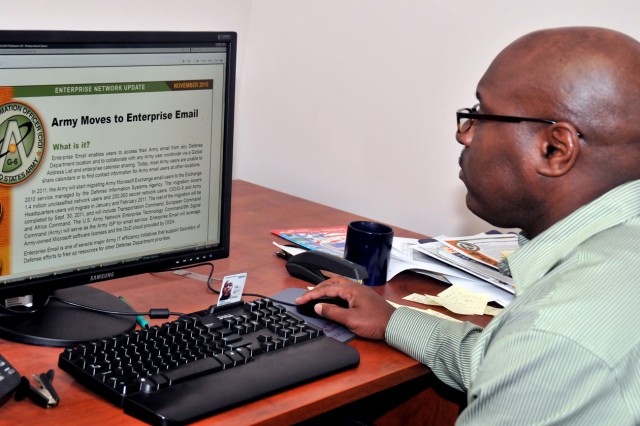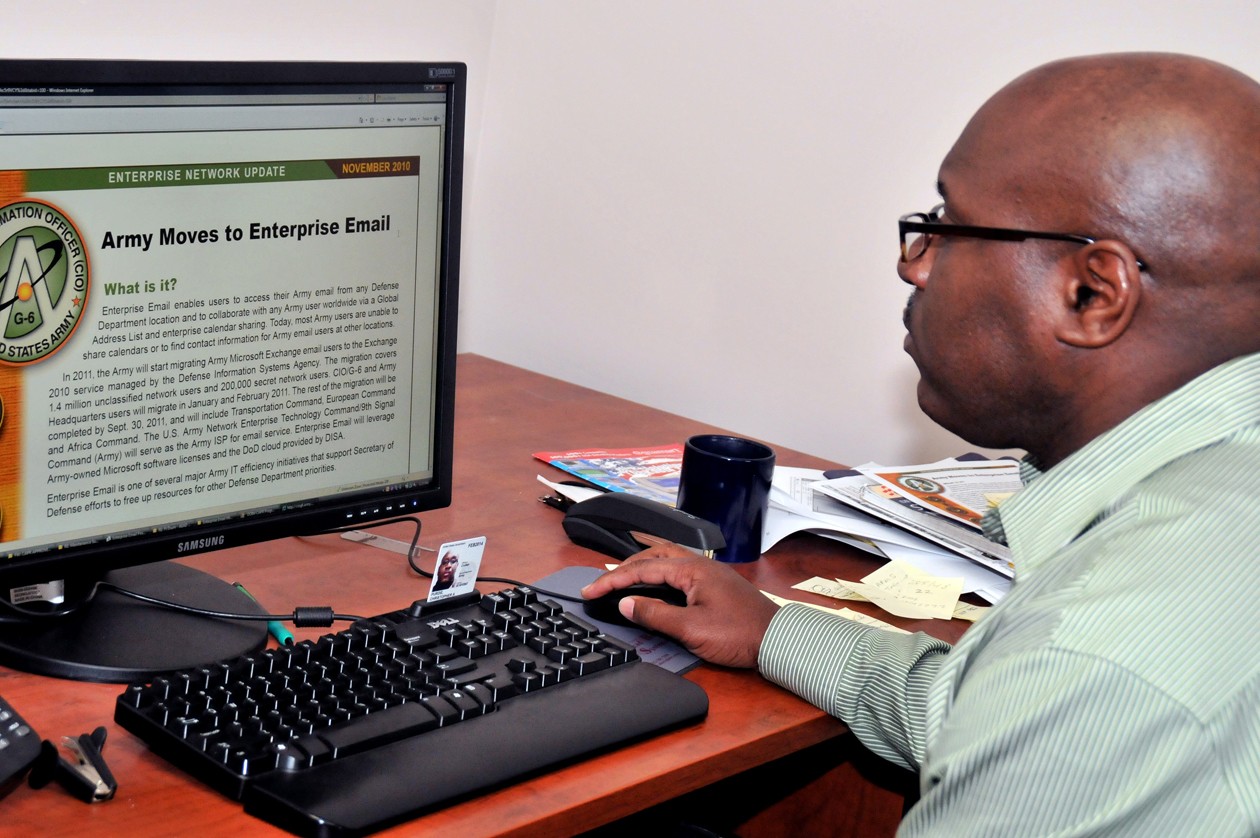FORT DRUM, N.Y. -- In cyberspace, Fort Drum and 10th Mountain Division (LI) computer users will relocate this summer.
The 10,000 user accounts at Fort Drum will be migrated incrementally to Enterprise Email beginning July 27 and ending Aug. 16. The new system will make e-mail addresses permanent for all users, even when they change organizations or duty stations, while also enabling users to access e-mail from any DoD-managed computer worldwide.
All Army user accounts in continental U.S. will be migrated by the end of October.
"We obviously won't migrate the entire installation in one fell swoop," said Chris Purdie, Enterprise Email Migration project manager at Fort Drum's Network Enterprise Center. "With the new e-mail, everybody will be on the same system. You will be able to look up anybody who works for DoD, whether they are military, civilian or contractor."
Managed by the Defense Information Systems Agency, Enterprise Email will allow collaboration with other DoD users through calendar sharing and use of a global address list. The "migration" to DISA servers in Fort Meade, Md., will eventually eliminate the need for servers at individual installations.
For the time being, account setups will still occur here, but DISA will provide all subsequent account management.
The Army-wide migration includes 1.4 million unclassified network users and 200,000 secret network users.
In addition to more user-friendly features, such as the ability to plug your common access card into any DoD-managed computer to check e-mail, the @us.army.mil address will become @mail.mil. Uniformed service members will also retain their old @us.army.mil address.
Naming conventions to further identify personnel will include a middle initial, numbers for personnel with common names and a military, civilian or contractor designation, which is critical for users with multiple personas, such as a contractor who is also an Army Reservist.
A specialist named John Mark Smith, for example, may have a new address that looks like this: john.m.smith97.mil@mail.mil; while a contractor named Yohan Felipe Tzpinski might not require a number: yohan.f.tzpinski.ctr@mail.mil.
E-mails directed to old Army addresses will automatically appear in one's new e-mail address for no less than six months with the help of AKO e-mail forwarding, according to Purdie.
In later stages of the migration, deploying troops will have access to their e-mail accounts at their home station - eliminating the need for secondary e-mail accounts down range.
Purdie said a few changeover challenges should not be too dramatic.
"The most obvious challenge will be that it's change," he said. "It's something different. But that's a normal challenge.
"Another challenge will be during the post-migration process. Once we do the migration, each user will have to move over their information from their old accounts."
One thing that won't change is the e-mail program: Microsoft Outlook 2007.
Purdie noted a major benefit of the new system will be cost savings.
"The effort will generate annual savings exceeding $100 million in fiscal year 2013 and beyond," he said. "The savings, especially in a day and age when we're trying to cut dollars everywhere, will be huge."
Purdie, who retired from the Air Force five years ago as an information technology project manager, said migration at Fort Drum will be scheduled by unit. To keep the process orderly, users will receive pre-migration instructions beforehand.
"We can't stress enough that users do exactly what these instructions ask them to do," Purdie said.
Tutorials and videos will be made available on how to perform both pre-migration and post-migration tasks. NEC personnel also will train S-6 shops and unit information management officers.
In addition, roughly six Enterprise Email training sessions will be held at the Multipurpose Auditorium in late June and July. Although attendance will not be mandatory, it will be strongly recommended.
Purdie also mentioned that a "tiger team" will be formed to specifically address technical issues during the migration.
"This team will drink, eat and sleep Enterprise Email Migration," he said.
Purdie recommends that users clean out their inbox and keep it below 50 megabytes in preparing for the migration.
"Maybe there are things that shouldn't even be in there," he said. "There are things you may need, and should file (elsewhere), and old items you don't need. It may be a good time to do some proper filing.
"Obviously, your inbox is always filling up," he added. "You can continually try to keep it down. But when this will be most pertinent is just before the migration."
Purdie estimated that each migration, which will occur overnight, will require roughly 20 to 30 minutes of post-migration work for each user.
To better prepare employees, the entire NEC was scheduled to migrate last night.
"That's what we do at the NEC," Purdie said. "Anytime there is something new coming out, we want to test it on us first. We are always going to use ourselves as guinea pigs.
"Anytime you deal with IT, you're going to see some things that might be some sort of anomaly," he added. "So we want to have the opportunity to look at that in-house first, in order to work it out.
"During the testing phase, you almost want to have some failures," he said. "Problem scenarios can provide good training. If everything goes perfect, you can't work out the bugs. As we conduct this migration, the onus is on us to mitigate any kind of customer headaches."


Social Sharing